Intel Pentium Gold G5600 And G5400 Review: Four Threads Under $100
Why you can trust Tom's Hardware
Final Analysis
Intel has a hard time adding features and functionality to its entry-level desktop CPUs without upsetting the balance of a carefully cultivated product stack. Improvements made to entry-level Pentium processors must extend upward through the Core i3, i5, and i7 families. After all, nobody is going to spend extra money on a higher-end chip unless it offers an appreciable advantage.
The Kaby Lake-era Pentiums gained Hyper-Threading support, allowing two execution cores to operate on four threads simultaneously. Intel then followed up with new Core models with additional cores, maintaining the status quo. It's only a bummer that today's Pentium processors still lack other features, such as AVX support and unlocked ratio multipliers. While those differentiators make sense in the context of Intel's portfolio, they're liabilities compared to AMD's Ryzen 3 2200G.
Intel's Pentium family was largely unharmed by first-gen Ryzen CPUs because they landed at higher price points and lacked integrated graphics. But that Ryzen 3 2200G is a different beast. It sells for less than $100, similar to the Pentium Gold G5600, and wields a Radeon Vega graphics engine that decimates Intel's UHD Graphics 630. Add in AVX instruction support and an unlocked multiplier for true enthusiast appeal.
In the chart below, we plot gaming performance with both average frame rates and a geometric mean of the 99th percentile frame times (a good indicator of smoothness), which we then convert into a frame-per-second measurement. We didn't include platform costs because these processors drop into value-minded platforms and come with decent stock coolers. It's noteworthy that we could overclock the Ryzen 3 2200G's CPU cores with AMD's stock thermal solution. However, you should buy something better if you also plan on tuning the chip's integrated Radeon Vega graphics. Also, bear in mind that we tested with an Nvidia GeForce GTX 1080 in order to alleviate graphics-imposed bottlenecks. Differences between our test subjects would shrink with more mainstream graphics cards installed.
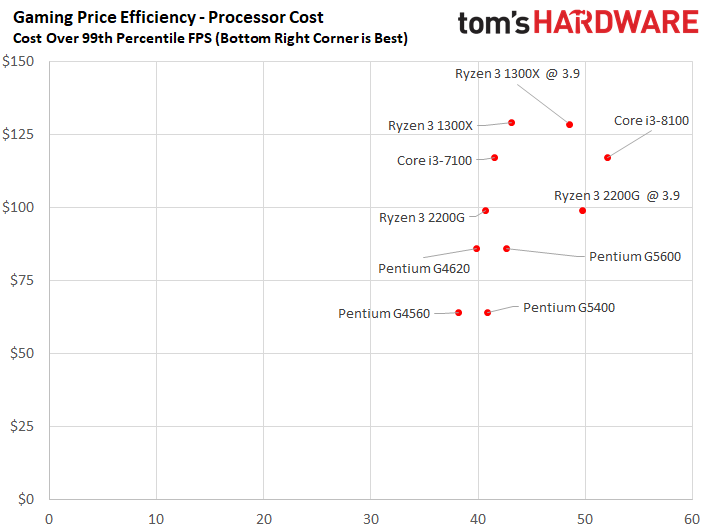
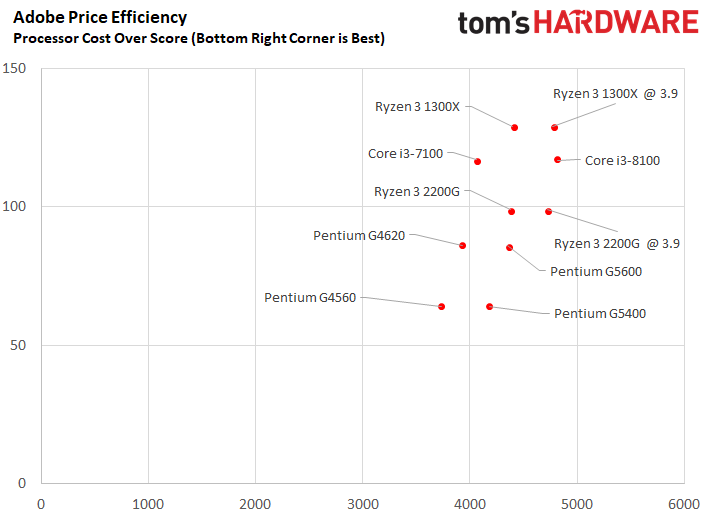
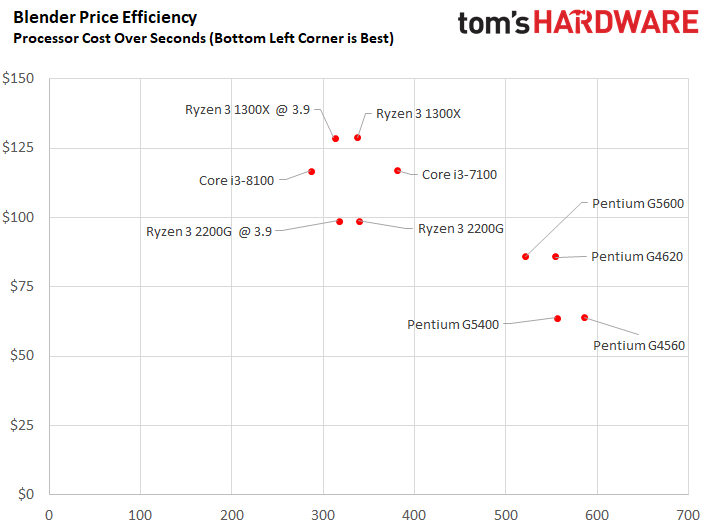
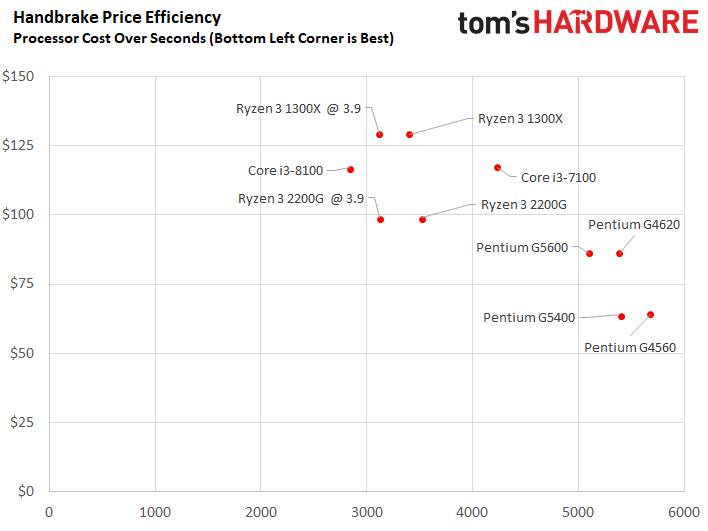
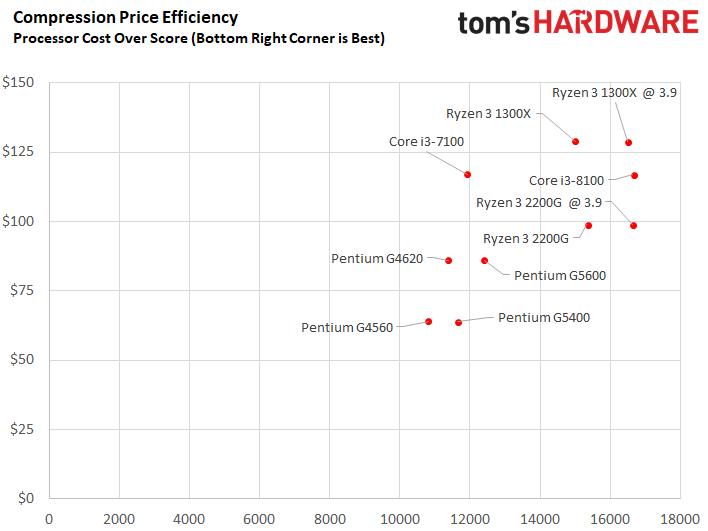
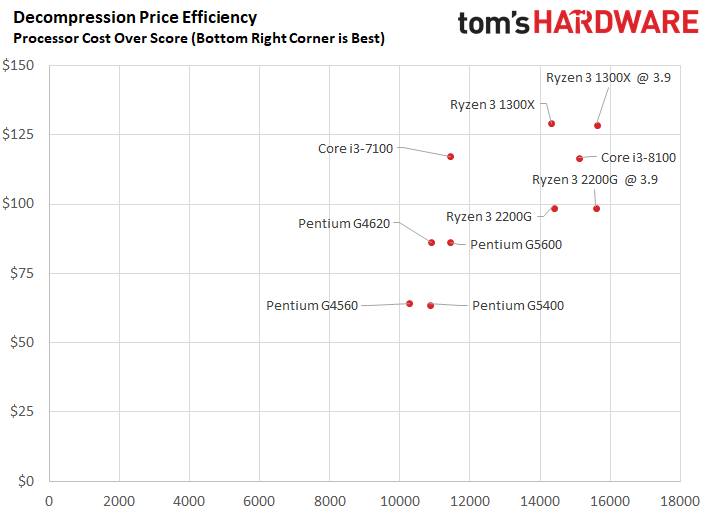
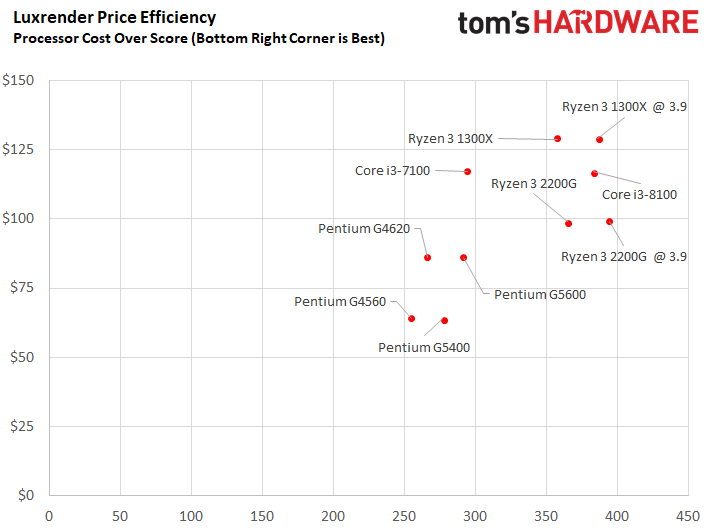
In games, a $100 Ryzen 3 2200G trailed Intel's Pentium Gold G5600 just barely at its stock settings. But overclocking the Ryzen made it competitive with the $117 Core i3-8100. As such, we're doubling down on our recommendation to pair the Ryzen 3 2200G up with an add-in graphics card for gaming. And it's even more convincing across our application tests. The 2200G's four physical cores and AVX support provide superior performance in threaded workloads. The chip even fares well in many lightly-threaded tasks—and that's before we take overclocking into account.
Due to a slightly lower clock rate, the Pentium Gold G5400 can't quite match the G5600's performance. It doesn't trail by much in our gaming and application tests, though. Although the Pentium sold at a premium immediately after launch, it's now available for $64. That $30 savings is worth considering, particularly if you reinvest those funds into a faster graphics card or larger SSD. Intel's Pentium Gold G5400 looks like a great choice for builders on tight budgets, and AMD has nothing to compete against its price point. At least for now, the Pentium Gold G5400 reigns uncontested.
MORE: Best CPUs
Get Tom's Hardware's best news and in-depth reviews, straight to your inbox.
MORE: Intel & AMD Processor Hierarchy
MORE: All CPUs Content

Paul Alcorn is the Editor-in-Chief for Tom's Hardware US. He also writes news and reviews on CPUs, storage, and enterprise hardware.
-
alchemy69 So you free admit in the first sentence that these chips are for people looking to build a sub-$500 system and so in the test rig you pair it with a GTX 1080?Reply -
logainofhades Reply21170547 said:So you free admit in the first sentence that these chips are for people looking to build a sub-$500 system and so in the test rig you pair it with a GTX 1080?
That is to show only CPU performance. You remove the GPU as a potential bottleneck. Benchmark review 101. -
TCA_ChinChin I think Intel did well in improving their pentium lineup. However, it would have been nice to see some more "real-world" examples like the pentium paired up with a gt-1030 and the r3-2200g with its built in graphics. Although testing without a GPU bottleneck will show absolute CPU performance differences (which is good), having some data more in context with the actual market segment of the product is also beneficial.Reply -
salgado18 I think the fact that they user a powerful GPU for CPU tests to remove bottlenecks should be in caps, bolded, in its own box. Every CPU review someone brings that up.Reply -
techy1966 Good review thanks. Using a good graphics card is a good way to show the CPU performance but it would have also been good to see all the CPU's also use their built in graphics chips. Which would have shown just how weak Intel's onboard graphics really is when compared to a AMD chip with built in graphics.Reply
For those that want to add a cheap graphics card to a low end Intel CPU system it will work well but if you do not want to do that then AMD's 2200G & 2400G CPU's are the only way to go if you want decent graphics performance on a tight budget. -
Paul Alcorn Reply21170900 said:Good review thanks. Using a good graphics card is a good way to show the CPU performance but it would have also been good to see all the CPU's also use their built in graphics chips. Which would have shown just how weak Intel's onboard graphics really is when compared to a AMD chip with built in graphics.
For those that want to add a cheap graphics card to a low end Intel CPU system it will work well but if you do not want to do that then AMD's 2200G & 2400G CPU's are the only way to go if you want decent graphics performance on a tight budget.
Here ya go, the Intel model isn't the same, but honestly it doesn't matter. Same UHD Graphics 630.
https://www.tomshardware.com/reviews/amd-ryzen-3-2200g-raven-ridge-cpu,5472.html
-
Nintendork When the 2200G APU (an i5 6600~) is at $89 you must be beyond blind to buy any intel cpu at that price bracket.Reply -
1_rick Reply21171365 said:When the 2200G APU (an i5 6600~) is at $89 you must be beyond blind to buy any intel cpu at that price bracket.
You can get the 2200G from Micro Center for $79, so it's even more off-balance. And that's been their online price for a while now, not just their in-store-only special. In light of that it seems like the G5400 is something you just should not get at all unless you really can't afford the extra $20 (Micro Center has the G5400 for $59) or you hate AMD. -
alchemy69 Reply21170631 said:21170547 said:So you free admit in the first sentence that these chips are for people looking to build a sub-$500 system and so in the test rig you pair it with a GTX 1080?
That is to show only CPU performance. You remove the GPU as a potential bottleneck. Benchmark review 101.
21170755 said:I think the fact that they user a powerful GPU for CPU tests to remove bottlenecks should be in caps, bolded, in its own box. Every CPU review someone brings that up.
I am well aware of the justification of this method but, imho, it is a nonsense metric. The raw power of the chip can easily be benchmarked with synthetics. Running game benchmarks with a vastly overpowered GPU is merely exchanging one bottleneck for another. What are you really measuring? How much this CPU bottlenecks the GPU in a given game. And who exactly is that information going to be useful to? If I'm reading the review of a new car I don't expect to see a discussion of how fast it could go if it was being towed by a Lambourghini.